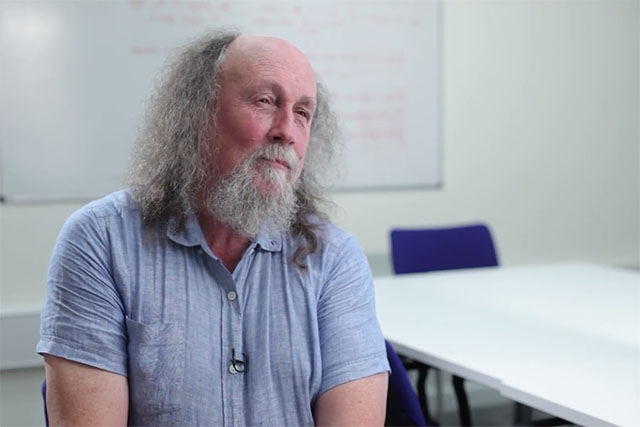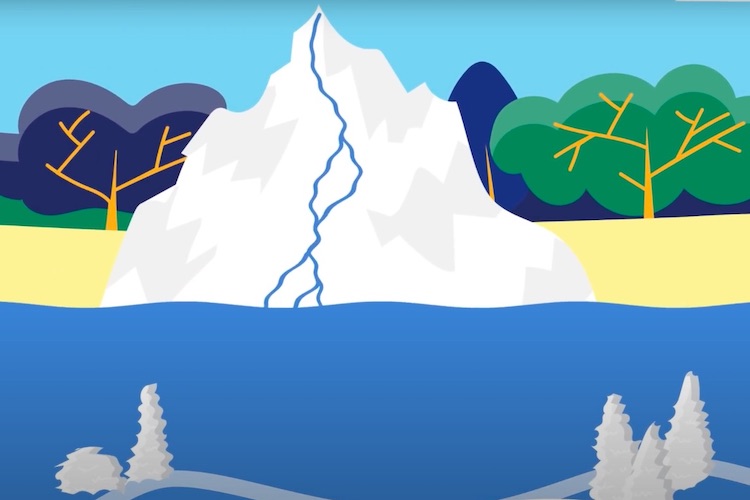Climate Change and Human Impact
Meteorologist Chris Brierley on the history of Earth and natural climate cycles
videos | July 18, 2019
I’d like to talk about climate change and human history and the interactions between them in the past. Clearly, if you go back far enough, about 50 million years ago or so, there’s no humans. It’s just after the dinosaurs have died out, and it’s a wonderfully warm world where crocodiles are living in the Arctic. Since then the world gradually cools and at some point about 30 million years ago we get ice sheets on Antarctica. Slowly the world cools more until you get to something about 5 million years ago when you start having those that we regard as our ancestors, human ancestors. That’s in a period called the Pliocene which I like to study: 5 to 3 million years ago. The Pliocene was still a warm world: it was a couple of degrees warmer than today but it had carbon dioxide levels of about 400 parts per million which is what I’m breathing today.
So there was this warm world and there were our ancestors in it. Over the course of this long cooling that the world’s experiencing you start crossing a threshold about 2.8 million years ago and the world starts going into glacial-interglacial cycles: it’s a technical term, ‘ice age’ is probably more common. You start getting really big expanses of ice coverings in North America and parts of Eurasia. These big expanses of ice absorb hundreds of meters of water, so the ocean drops by a hundred meters. There’s a sawtooth pattern to this: it’s cold for about 90,000 years and then it suddenly gets warm again for 10,000 years and that pattern goes through. Sometime about 2 million years ago you start seeing changes in the tropical circulation which impact the climate of Africa. Whether the climate of Africa becomes drier or whether it’s that the climate Africa becomes more variable and the lake levels start changing we’re not really sure, but something in that climate change leads to the development, the evolution of our ancestors into something that we recognise as Homo, the human family. Those ancestors live in Africa for quite some time and then they slowly spread out over the last 100 thousand years or so out and across Eurasia. You get anatomically modern humans coming in.
Then there’s a period of stable climate which sits for about 10 thousand years. The real depth of the last ice age was about 20 thousand years ago and the ice was in greatest extent and then it starts melting, decaying away, and sea level starts rising. As that happens the world’s gradually warming up. In the depth of the last ice age, you’re looking at a world about four degrees colder and the carbon dioxide level was about a hundred parts per million, below the preindustrial level. Then the carbon dioxide level starts rising, the ice sheets start falling away and this is all driven by changes in the Earth’s orbit. There’s no human influence in it at all.
After about 10 thousand years the majority of the ice is all completely away and you get left with a very stable climate that persists for about 10 thousand years: it changes slightly but it’s generally a flatten, nice and stable climate. Within that stable climate of this period called the Holocene you start to see real innovations taking off in human culture. About 9,000 years ago you see the first aspects of domestication: over in the Fertile Crescent you’re getting crops. Then domestication occurs independently elsewhere: in China about 6-7 thousand years ago, in New Guinea about 4 thousand years ago and over in the Americas as well between 5-6 thousand years ago.
So you’re getting this convergence of human culture into farming and moving from hunter-gatherers into farming. That pulls through to changes in the way we live: once you have a farming civilization and you’re sedentary then it’s clearly worth putting more effort into way you live. You might also be making a surplus, so you can afford to use an extra food to supply a higher civilization. You see the births of these first civilizations. Interestingly, one of the most famous ones, the Egyptian civilization is thought to be slightly influenced by the climate getting worse. About somewhere between 14 thousand years ago and 6 thousand years ago the Earth’s orbit was such that there were large rains in northern Africa moving really quite far north. You end up with a period that ‘s referred to as a ‘green Sahara’: it doesn’t mean the whole thing was covered with grass but it was certainly a lot greener than it is today. In that green Sahara, there were peoples living, and about 6,000 years ago you start getting the first pastoralists, cattle herders. Those pastoralists were able to stick around despite the climate getting worse because the orbit was changing very slowly back, and so it was turning into the dry Sahara we know now. But it didn’t turn quite as fast as it perhaps should’ve, because those cattle herders were able to support the climate through moving nutrients around and helping the vegetation. But at some point, it becomes too much even for them and they have to retreat from the Sahara. And if you’re in northern Africa in the desert region, what do you want to retreat to? You want to retreat to the area that has water available which is the Nile valley. You see an inward migration on to the Nile Valley and with that greater population density, there is more requirement for a social structure. You start getting into the Egyptian civilization. The climate is generally stable but with these slight worsenings and slight betterings, and it caused the technological innovation which, in a cultural sense, is what’s spurring civilization onwards.
You have this technological innovation and then there are cycles of this: the climate just naturally gets a little bit warmer or a little bit colder. Maybe it’s just the northern hemisphere, we don’t know. So you have the Roman Warm Period: it was all whilst the Roman Empire spread over and there was technological innovation associated with it; cultural innovation: not all of it pleasant, of course, but it’s moving onwards. Then it gets colder going into the Dark Ages here in Europe and then as the climate gets warmer again into the medieval period you start seeing this blossoming of culture. The last move in the historical climate is referred to as the Little Ice Age: this was a period from about 1450s to 1850s when it’s noticeably colder. Predominantly that’s natural where you’re getting slightly less sunspots (and sun sunspots sign for the amount of energy that reaches the Earth’s surface) and therefore if you have less energy it gets colder. The other thing that changes the amount of energy reaching the Earth is big volcanoes. A big volcanic eruption puts lots of dust up in the atmosphere and that stops the sun’s energy coming through and leads to a slightly colder world. And if you have a lot of volcanoes going off in general, it can lead to cooling.
Then in 1492 Columbus and his fleet set off out across the Atlantic and discovered the New World, or the Americas, and as he went he very kindly brought things like Christianity, but also slavery and subjugation and diseases like smallpox. It killed the indigenous population which went from about 60 million people to about 6 million people in the course of 100 years. As they died off they weren’t farming and the trees reclaimed their hand. Slowly, as the trees were reclaiming their land, they were also sucking carbon dioxide out of the atmosphere and that leads to a slight cooling.
So you have this natural Little Ice age where the sun’s not shining as much as it could and there are some volcanoes going on. These are really small background things but they have a big impact on the climate system. On top of that, there’s this very small (in today’s context) drown of CO2 from reforestation that leads to a slight cooling.
From about the 1850-s or so you start seeing the impact of the industrialization and the increase of fossil fuel burning. It leads to a much greater level of carbon dioxide reaching the atmosphere and that’s leading to the global warming that we’re going through today and will continue over the course of the next hundred years or so. As we move into the future at some point humans will stop emitting more carbon dioxide into the atmosphere and it will balance out: maybe on our own free will (that’s what I hope for) but it might be that climate gets so bad that society collapses and the population collapses, so it acts as a natural brake on the amount of emissions. I don’t want that to happen… But at some time the carbon emissions will level off and then it’ll take about a hundred or two hundred years for the atmosphere to equilibrate, to reach the level associated with those carbon dioxide emissions and another few thousand years for the sea level rise to finally kick in as the ice sheets are slowly melting away. That carbon pulse through our industrialization will level off and then over tens and thousands of years the natural geological cycles should start coming into play and drawing down that carbon dioxide. Whether we then go into an ice age, it draws down that quickly (maybe a hundred thousand years of preservation through the human influence on the climate), or whether we put so much in there that the world has found a new stable state like back on the Pliocene (4-5 million years ago) and stays on that level until it gradually cools down and we have to go through the cycle of ice ages again, I’m not sure.
There was a time when the climate was naturally varying and impacting humans. But now we’ve crossed into the point where the climate is being driven by humans and at some point, on geological timescales, we will return to the setting where the natural processes in the Earth system change the climate again.





























